Hashimoto’s Eye Disease Impact
Understanding Hashimoto’s Eye Disease
Hashimoto’s Eye Disease Impact Hashimoto’s eye disease is part of a problem with the immune system. It affects the thyroid gland and the eyes. Knowing about this helps us take better care of our health.
What is Hashimoto’s Thyroiditis?
Hashimoto’s thyroiditis is when the body’s defense system attacks the thyroid gland. This can make the thyroid not work well, which is called hypothyroidism. It can lead to many issues. It’s important to know that eye problems can start from thyroid problems.
Connection Between Thyroid and Eye Health
The thyroid’s health is closely linked to eye health. Changes in thyroid hormones can affect eye muscles and tissues around the eyes. Inflammation from thyroid disorders like Hashimoto’s can even reach the eyes, causing trouble. Hashimoto’s Eye Disease Impact
| Aspect | Thyroid Impact | Eye Impact |
|---|---|---|
| Hormone Regulation | Controls metabolism and energy levels | Affects eye muscle function and orbital structure |
| Inflammation | Thyroid gland becomes inflamed | Results in eye inflammation and discomfort |
| Autoimmune Response | Misguided immune attacks on thyroid | Similar immune attacks can target eye tissues |
Seeing how Hashimoto’s thyroiditis and eye problems are linked highlights the need for full-body care. Taking care of the thyroid not only helps with the body’s energy but also with eye problems. Hashimoto’s Eye Disease Impact
Common Symptoms of Hashimoto’s Thyroid Eye Disease
Finding hashimoto’s thyroid eye disease symptoms early is key for good care. This disease can start off light or strong. Knowing the signs early helps to get help soon. Hashimoto’s Eye Disease Impact
Initial Signs to Look For
The initial signs of thyroid eye disease are small changes in your eyes. You might feel dryness, grit, and see a bit of swelling. Even if the signs are light, they show the start of Hashimoto’s thyroid eye disease. Hashimoto’s Eye Disease Impact
Progressive Symptoms
As it gets worse, you’ll notice bigger and more troubling signs. This includes pressure or pain near the eyes and bulging eyes. It’s important to detect and treat these progressive symptoms of eye conditions early. Hashimoto’s Eye Disease Impact
Keeping an eye on the hashimoto’s thyroid eye disease symptoms can avoid bad problems. Quick action can make life better for those with the condition.
How Hashimoto’s Eye Disease Affects Vision
Hashimoto’s eye disease changes how we see the world, making daily life hard. This happens when the eye muscles get swollen and inflamed. It causes major problems with vision.
Blurred Vision
Thyroid eye disease can make things look fuzzy first. This happens early and can get worse with time. Getting the right treatment is key to make things better.
Double Vision
Seeing two of everything is called diplopia. It’s because eye muscles are not working together right. Early help is very important to fix this.
Vision Loss
Sometimes, people with this disease can lose their sight. This can happen if the optic nerve is pressed. Catching and treating the problem early is crucial. It saves your eyes from lasting harm.
| Symptoms | Description |
|---|---|
| Blurred Vision | Things don’t look clear, they seem fuzzy or not right. |
| Double Vision | You see double of one thing because your muscles are not working. |
| Vision Loss | You might see less or not at all, often because of nerve problems. |
It’s important to know these signs and how serious they can be. Talking to a doctor about Hashimoto’s eye disease treatment can make life better.
Hashimoto’s Eye Pain: Causes and Relief Measures
Hashimoto’s eye pain can be very intense. It is often caused by inflammation on the ocular surface or the eye muscles. It’s key to know the causes of thyroid-associated eye pain for better management and relief.
Common Causes
The main reasons for eye pain in Hashimoto’s patients include chronic inflammation, dryness, and pressure in the eye socket. This happens because the immune system attacks the eye tissues wrongly. Such attacks can lead to a lot of pain and discomfort.
Pain Management Techniques
It’s important to manage pain for those with Hashimoto’s eye issues. Ways for hashimoto’s eye pain relief vary from simple home tricks to more complex medical steps. Here are a few methods:
- Lubricating eye drops are good for dryness and discomfort.
- Anti-inflammatory drugs, both by mouth and on the skin, can ease swelling and pain.
- Doctors might suggest steroid shots in critical cases to reduce inflammation fast.
- For severe situations, orbital decompression surgery could be needed to ease eye pressure and pain.
By managing ocular discomfort with these steps, people with Hashimoto’s thyroiditis can live better. They can lessen the effect of this autoimmune issue on their daily life.
Diagnosis of Hashimoto’s Eye Conditions
Finding out if someone has a Hashimoto’s eye condition is really important. For the right treatment, doctors need to carefully look at the problem. They use special tools to do this.
Medical Tests and Procedures
Doctors do a lot of tests to check for Hashimoto’s thyroiditis eye issues. These medical tests for thyroid eye disease might include:
- Clinical Assessment: First, a detailed look at the eyes and any symptoms by a doctor.
- Imaging Tests: Then, pictures like CT scans or MRIs to see how bad the problem is.
- Blood Tests: Blood tests to figure out how the thyroid and eyes are being affected by the immune system.
These tests help the doctors know exactly how Hashimoto’s is affecting the eyes. This way, they can come up with the best plan to help.
Consulting a Specialist
Getting help from eye specialists is a big part of dealing with Hashimoto’s eye issues. You may need to see:
- Endocrinologists: These are pros in thyroid problems. They can help with your thyroid and eye health.
- Ophthalmologists: These are eye doctors that know a lot about thyroid-eye problems. They can do special eye treatments or surgery if needed.
Having these specialists on your team means you get the best care. They can help from the first test to making a treatment plan that works best for you.
Effective Treatments for Hashimoto’s Eye Disease
Dealing with Hashimoto’s eye disease needs a wide approach. It focuses on fighting the autoimmune reaction, easing inflammation, and keeping eye health safe. Patients have access to various treatments, such as medicines, surgery, and home care.
Medication Options
Medications play a big part in hashimoto’s eye disease treatment. Doctors often recommend steroids and drugs that lower the immune system. This helps reduce eye swelling and calm the immune system. They are also looking into newer biologic drugs that target the root cause of the disease.
Possible Surgeries
If drugs don’t work, surgical interventions for hashimoto’s eye might be needed. A key surgery is orbital decompression. It reduces pressure on the eyes and helps with eye swelling. Eyelid surgeries are also an option. They fix problems like drooping or bulging eyes, making eyes work better and look better.
Home Remedies
Home remedies can add to regular treatments and make you feel better. For example, using warm compresses on the eyes can reduce swelling. Some also find that taking selenium, a type of supplement, helps keep their thyroid and eyes healthy. These easy-to-do home treatments are key parts of a full hashimoto’s eye disease treatment plan.
| Treatment Type | Description | Purpose |
|---|---|---|
| Medications | Steroids and immunosuppressants | Reduce inflammation and manage immune response |
| Surgical Interventions | Orbital decompression and eyelid surgery | Relieve pressure and correct functional/cosmetic issues |
| Home Remedies | Warm compresses and selenium supplements | Alleviate discomfort and support overall health |
Complications and Long-term Effects of Hashimoto’s Thyroiditis on Eyes
Hashimoto’s thyroiditis affects eyes in a big way over time. This often shows up as constant inflammation. A major problem is fibrosis in the eye’s orbital tissues. It makes moving the eye hard and can be painful.
As the problem gets worse, people might end up with eyes that don’t line up right. This can cause seeing double or have a hard time focusing. Another big issue is corneal exposure. Since the eyelids don’t close all the way, the cornea gets dry. This can lead to sores and make it hard to see.
There’s also a risk for optic neuropathy. This is when the optic nerve gets swollen or pressurized. It can make vision slowly get worse. Getting eye checkups often is very important. It helps find and deal with eye problems from Hashimoto’s early.
| Complication | Description |
|---|---|
| Strabismus | Misalignment of eyes causing double vision. |
| Corneal Exposure | Drying and potential ulceration due to incomplete eyelid closure. |
| Optic Neuropathy | Damage to the optic nerve resulting in vision loss. |
Knowing what Hashimoto’s can do to eyes is very important. It helps keep a close watch and act early to protect the eyes.
Hashimoto’s Thyroid Eye Disease Pictures: What to Expect
Seeing Hashimoto’s thyroid eye disease pictures can help understand how it changes over time. These pictures show the start with swelling and redness. Then they move to bulging eyes and eyelid problems, like eyelid retraction.
Looking at these visuals helps those with thyroid eye issues. They give a clear picture of what you might see. This can help patients and doctors know how to treat it better.
Key visual aspects of Hashimoto’s Thyroid Eye Disease:
- Initial stages showing mild puffiness and eye redness
- Intermediate stages with more bulging eyes and lid retraction
- Severe stages might show optic nerve issues
These pictures are a key part of understanding thyroid eye problems. They help everyone know what to expect.
| Stage | Visual Characteristics | Common Symptoms |
|---|---|---|
| Early | Puffiness, Redness | Mild discomfort, Dryness |
| Intermediate | Bulging Eyes, Lid Retraction | Double Vision, Eye Pain |
| Severe | Optic Nerve Compression | Vision Loss, Severe Pain |
Expert Advice from Acibadem Healthcare Group on Managing Hashimoto’s Eye Issues
Hashimoto’s eye disease can really affect how well someone sees and lives their life. Acibadem Healthcare Group knows a lot about how to help. They say it’s important to use many ways to treat it, like medicine, changing how you live, and checking your health often.
Interview with a Specialist
In an important talk, a specialist from Acibadem Healthcare Group explained how to handle Hashimoto’s eye problems. They said spotting it early and staying on top of it are key. Medicine like anti-inflammatory drugs and immunosuppressants can help. They push for making a plan that fits each patient’s unique symptoms and health.
Recommended Practices
Acibadem Healthcare Group gives advice on looking after Hashimoto’s eye disease well. It’s good to have eye checks often to watch for any changes. Eating right is important for a strong immune system. They also suggest ways to stress less, like being mindful and getting moving. The key is to teach patients a lot about their condition and how to handle it.
FAQ
What is the impact of Hashimoto's eye disease on ocular health?
Hashimoto's eye disease can cause big problems for your eyes. It's linked with Hashimoto's thyroiditis. You might feel discomfort or see less well. You could even lose some vision. It's crucial to spot it early and treat it well to stay healthy.
How does Hashimoto's thyroiditis affect the eyes?
Hashimoto's thyroiditis harms the eyes by creating inflammation. This attack on the thyroid can change the eyes because of hormone shifts. This can hurt the tissues around the eyes and how the eye muscles work.
What are the common symptoms of Hashimoto's thyroid eye disease?
Hashimoto's thyroid eye disease can start with simple problems. You might feel your eyes are dry or see them puffy. Soon, it could lead to more severe issues like eye pain or looking like your eyes are bulging. Early signs of these symptoms are important to note.
How does Hashimoto's eye disease affect vision?
Hashimoto's eye disease might make you see blurry or double. In bad cases, it can make you lose some of your sight. Quick treatment is key for keeping your vision safe and your eyes working well.
What causes eye pain in Hashimoto's thyroid eye disease, and how can it be managed?
In Hashimoto's thyroid eye disease, eye pain comes from swollen eye parts or eye muscles. You can treat it with eye drops and some medicines. Sometimes, you might need a special kind of surgery to feel better.
How is Hashimoto's thyroid eye disease diagnosed?
Doctors diagnose it with a full check-up and special images of your eyes. They also check your blood for thyroid problems. It's key to see a doctor who knows a lot about this condition for the best care.
What are the effective treatments for Hashimoto's eye disease?
There are many ways to treat it, like with medicines or surgeries. You can use some home treatments too, like warm eye covers. These treatments can help control symptoms and keep your eyes safe.
What are the possible long-term effects and complications of Hashimoto's thyroiditis on the eyes?
As time goes on, it can cause more eye problems that may not go away. These could make your eyes turn in different directions or cause other vision issues. But with regular care, you can stop these from happening.
What can be observed in pictures of Hashimoto's thyroid eye disease?
Pictures can show how this disease changes your eyes over time. They help doctors and patients see what to expect. This makes it easier to manage the disease well.
What expert advice does Acibadem Healthcare Group offer on managing Hashimoto's eye issues?
Acibadem Healthcare Group says managing these eye issues needs a mix of medicine, lifestyle changes, and always checking on your eyes. Their experts know that good care of the eyes, along with other treatments, is very important.













